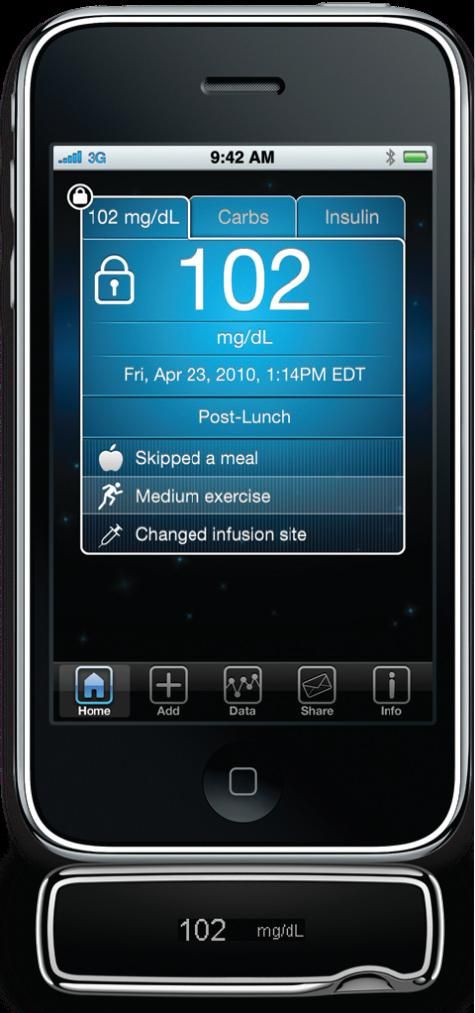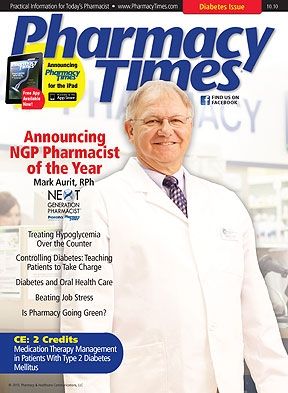Technology News

Diabetes advocates have long called for a more intuitive and accurate blood glucose monitor that meets the technology standards of today’s plugged-in patient. Sanofi-aventis has answered that call with the introduction of iBGStar, a new glucose meter that plugs directly into an iPhone or iPod touch.
The meter looks nothing like the clunky beeper like devices that have become a hallmark of living with diabetes. Its shiny black face and chrome backing perfectly match the Apple aesthetic—a goal its developers kept in mind while designing the product. Sanofi-aventis worked with AgaMatrix, a developer and manufacturer of diabetes products, to complete their vision.
Readings are displayed both on the meter itself and in full color on the iPhone or iPod touch screen with the help of the iBGStar Diabetes Manager App. A new testing method developed by AgaMatrix ensures more accurate blood glucose readings. Through the app, patients can track blood glucose, carb intake, insulin dose, and any relevant notes to create an individualized record that can be accessed on the go.
The iBGStar’s US launch is still subject to 510(k) clearance from the FDA, which currently does not recognize the iPhone as a medically approved device. That caveat has not quelled enthusiasm for the iBGStar among US patients, however.
In a post announcing the unveiling, diabetes blogger Amy Tenderich called the iBGStar “the first major proof-point” that iPhones and their brethren are becoming critical tools in the management of chronic illness. “I for one am really excited to see the industry knocking down FDA walls to integration of consumer and medical products,” she wrote.

Texting Helps Patients Adhere to Treatment
A new study found that patients who receive regular medication reminders and patient education information via text message show improvements in medication adherence and self-care.
The results of the study, which were published in the journal Dermatology Research and Practice, add to the growing body of research that supports text messages as a cost-effective way to reach patients between appointments.
Researchers from the Center for Connected Health, a division of Partners HealthCare in Boston, provided daily text messages for a 6-week period to 25 adolescents and adults aged 14 years and older. The patients recruited had atopic dermatitis (AD), a chronic skin condition for which adherence is typically poor, according to the study.
Content of the text messages included reminders, such as “Please remember to use the medication or product you use to treat your atopic dermatitis today!” and educational information, such as a list identifying common triggers of AD flare-ups.
At the end of the 6-week study period, patients reported fewer incidences of forgetting medication and were more likely to take preventive measures to protect their skin. The results also translated to clinical improvements, with patients exhibiting less severe symptoms following the treatment period.
If properly adapted, the texting method could be incorporated into pharmacy practice as an extension of medication therapy management. Treatments for AD often involve OTC medicines, presenting an ideal opportunity for pharmacists to become involved in caring for this patient population.
“Delivering education about AD through [text messages] may help patients to learn more about their skin disease and the behaviors that could help prevent flares,” the study’s authors concluded.
Invisible Bracelets Provide Concrete Protection
Medical identification (ID) jewelry has taken a variety of forms over the years, from key chains and dog tags to the tried and true standard, medical alert bracelets. An innovative new service offered by the company Docvia proves that emergency medical data need not be chained to a trinket.
Invisible Bracelet, or iB, is a Webbased medical ID system that assigns patients a personal identification number (PIN) for an annual cost of $10. The PIN is then printed on wallet cards, key chains, stickers, or snap-on tags for clothing. When an emergency occurs, medics can either text the PIN to the number 51020 or enter it into the iB search registry to receive detailed emergency information.
If the patient is transported to the hospital, emergency responders can use iB to notify as many as 10 emergency contacts. Because the service depends on the cooperation of medical professionals to function, iB has partnered with the American Ambulance Association to provide free online training and licenses to providers. Pharmacists can get more information or refer patients to the service by visiting www.invisiblebracelet.org.

